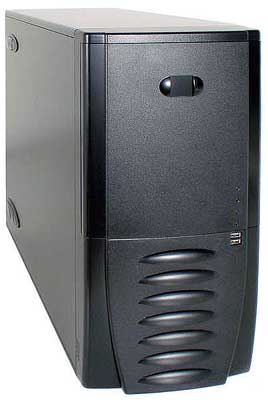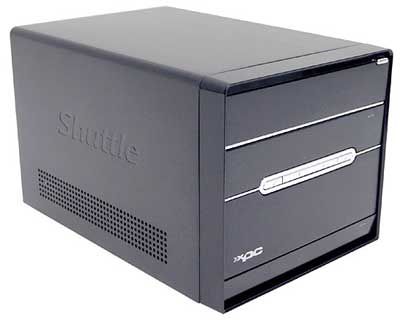Buyer's Guide - Mid-Range, October 2004
by Jarred Walton on October 21, 2004 11:00 AM EST- Posted in
- Guides
Case and Power Supply Recommendations
Choosing a case can be as simple or as complex as you want to make it. Some people want a lot of bling-bling, others want silence, and still others want cooling and expansion capabilities. For a mid-range system, $100 is a good ballpark figure for the cost of the case, although you can easily spend more. A quality case with a 350W or higher power supply (PSU) should be sufficient, but for gaming systems with their more power hungry graphics cards, it might be a good idea to purchase a separate PSU.
Case Recommendation: Antec SLK3700-BQE with 350W PSU
Price: $91 Shipped (Retail)
For a classic design with a reliable power supply and good features, we like the Antec SLK3700-BQE. The hard drive assembly is nice to work with, and the included 120mm fan is nearly silent. The fan on the PSU is a little louder, but not enough to really disturb anyone. Unfortunately, the case requires tools for most of the assembly - only the side panel can be removed without using a screw driver. If you do not upgrade frequently, this is not a major concern. Adding a second 120mm fan on the front of the case can help with cooling, although it does add to the noise levels. There is an easy-to-clean filter in the front of the case, which can help to eliminate bunnies from the inside of your computer. You should still clean your PC interior at least once or twice a year, but it does keep out some of the dust. Overall, the case is very well designed and the included PSU is of relatively high quality.

Case Alternative: Thermaltake VA3000 Dream Tower Tsunami with 400W PSU
Price: $131-135 Shipped (Retail)
We reviewed the Thermaltake Tsunami recently and were impressed with the design and attractive look. It is available in both silver and black, with or without a window, and some vendors include a 400W PSU in the bundle (like Newegg, where we found this price). The windowed version costs a little more, but internally, the cases are the same. The case includes two relatively quiet 120mm fans for effective cooling, and while it may not be the easiest case to set up, it does have a partially tool-less design and the looks make up for many of the deficiencies.

SFF Case Alternative: Shuttle XPC SN95G5
Price: $299 Shipped (Retail)
As a final case alternative, we offer the latest Shuttle XPC SFF case - note that this is only for socket 939 CPUs, but there is a socket 775 version available as well, the SB83G5. These days, you can't swing a bat without hitting a SFF case, so look around a bit if you want something different. (Can you tell that it's playoff season?) While the price is rather high, remember that you do not need a motherboard or a CPU HSF. In the end, the Suttle SFF we recommend here adds about $50 compared to the base socket 939 platform.
We hope to have a review of this case in the near future, but the latest G5 cases from Shuttle appear to be better in most areas when compared to their predecessors. Expansion options are limited compared to tower cases, but if desk space is a concern, SFFs are great. Throw in an LCD, and you're all set. Inexperienced PC builders may find SFF cases a little more difficult to work with, due to the cramped space, but they aren't much worse than regular cases. Note that unlike many other SFF cases, there are no integrated graphics in the SN95G5, so a graphics card is required. Dual-slot graphics cards will not fit in the case, so if you're thinking of getting a 6800 Ultra, you'll want to look elsewhere.










54 Comments
View All Comments
hh - Friday, October 22, 2004 - link
#8/gimper48> Very good. I am impressed. However, are we
> going to see benchmarks in these anytime soon?
Benchmarks are merely a tool to try to determine whats better/worse/"equivalent" for its price.
And I do realize that this may be somewhat contrary to the general intent of the article, but we do have to recognize that DIY'ing falls into two basic motivational catagories: those who do it because they enjoy it (hobby) and those who want to save money vs. OEM (value).
For the latter, it comes down to cost:performance. As a example, taking the $1250 system upgraded to the 17" LCD monitor and XP/P OS puts us at roughly $1500. Now suppose that we could get an "equivalent" system (performance) but someone else did the assembly, optimization and compatibility hassles, performed the OS installation, and gave us a warranty. Clearly, that PC build wouild be worth more, but how much more?
One OEM example to consider is the Apple iMac 1.6Gz G5 17" at $1300 + 1GB aftermarket RAM upgrade +$250, which puts us at a $1550 pricepoint.
For this example, the value-added extras of hardware assembly, optimization/compatibility/debug, the OS install and a system warranty is only $50 more. YMMV if this is small enough for many value-oriented people would be willing to pay for (IMO, yes).
The remaining question is if such a $1550 OEM system is/isn't "equivalent" to the $1500 DIY system to conclude which is the better overall consumer value.
And because of the Apple here, the "equivalency" question is a huge gaping hole. That's no accident: I did it on purpose because my intent is to look at this more rhetorically to as to illustrate the philisophical, not to introduce a Mac performance debate (so please don't). Yes, I could have chosen a Dell or Gateway, but I loathe their websites and they typically have too many hardware variables that would only drag us down into the weeds instead of seeing the basics of the big picture first.
This article was interesting reading. Thanks again.
-hh
draazeejs - Friday, October 22, 2004 - link
Why did they change the HDD recommendation from Seagate to Samsung? Does anyone have experience with how loud those drives are? I have a Barracuda IV, 40GB, and that one is totally silent. As far as I have heard the new Barracudas are much louder. Why is that so?PrinceGaz - Friday, October 22, 2004 - link
If the NEC ND-3500A lives up to the standards of the previous ND-2500A/2510A, then its likely to be the best drive in its class with standard firmware. The quality and value of those drives was unbeatable.Hacked firmware to add more media types or higher burn speeds with them is a nice bonus for those who want it, but is totally optional. The drives are still excellent straight out the box.
deathwalker - Friday, October 22, 2004 - link
#28..I don't think recommendations for a Optical drive should be based on "hacked" firmware...I'm sticking with my original thought that the Pioneer drive would have seemed like the likely choice based upon there recent review..having said that though, I'nm sure the NEC drive is a fine drive also.MustISO - Friday, October 22, 2004 - link
Looking at the memory chart, RAM is really going up. That sucks!iversonyin - Friday, October 22, 2004 - link
logitech > MS when it come to mouseMIDIman - Friday, October 22, 2004 - link
> The NEC is a little curious though, given the> glowing review of the Pioneer a few weeks
> ago...
I think the point here might be post hacked firmware. After flashing my 3500a, its quite incredible what its capable of, and its possible that anandtech has already done an NEC article and just hasn't put it up quite yet.
Murmandamus - Friday, October 22, 2004 - link
Great guide!I'm considering setting up an HTPC. So I would sure like to see a htpc guide from you guys.
Thanks!
JarredWalton - Friday, October 22, 2004 - link
Let's just say I have insider information from Kristopher. Blame him. ;)gherald - Friday, October 22, 2004 - link
> #5 - Posted on Oct 21, 2004 at 1:34 PM by PrinceGaz wrote:> I've just finished reading it and amazingly, I can't fault any of your recommendations!
I have to agree! In particular it's great to finally start seeing good case/PSUs from Antec and Shuttle.
The NEC is a little curious though, given the glowing review of the Pioneer a few weeks ago...